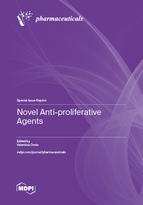Novel Anti-proliferative Agents
A special issue of Pharmaceuticals (ISSN 1424-8247). This special issue belongs to the section "Medicinal Chemistry".
Deadline for manuscript submissions: closed (20 May 2023) | Viewed by 47995
Special Issue Editor
Interests: medicinal chemistry; nitrogen heterocycles; antiproliferative compounds; enzyme inhibitors
Special Issues, Collections and Topics in MDPI journals
Special Issue Information
Dear Colleagues,
Cancer is one of the most widely spread and complex forms of disease, cancer cells being distinguished from healthy cells for their altered proliferation and survival. In the past three decades, only the National Cancer Institute (NCI) has screened millions of small molecules for potential anticancer activity. Despite a number of conventional cytotoxic approaches having been developed, their limited effectiveness, in accordance with the heterogeneity of cancer cells, prompts the constant search for novel natural or synthetic compounds with growth inhibition or tumor cell activity killing properties.
This Pharmaceuticals journal Special Issue invites both reviews and original articles regarding basic, preclinical and clinical studies on antiproliferative chemical entities.
I look forward to receiving your contribution.
Prof. Dr. Valentina Onnis
Guest Editor
Manuscript Submission Information
Manuscripts should be submitted online at www.mdpi.com by registering and logging in to this website. Once you are registered, click here to go to the submission form. Manuscripts can be submitted until the deadline. All submissions that pass pre-check are peer-reviewed. Accepted papers will be published continuously in the journal (as soon as accepted) and will be listed together on the special issue website. Research articles, review articles as well as short communications are invited. For planned papers, a title and short abstract (about 100 words) can be sent to the Editorial Office for announcement on this website.
Submitted manuscripts should not have been published previously, nor be under consideration for publication elsewhere (except conference proceedings papers). All manuscripts are thoroughly refereed through a single-blind peer-review process. A guide for authors and other relevant information for submission of manuscripts is available on the Instructions for Authors page. Pharmaceuticals is an international peer-reviewed open access monthly journal published by MDPI.
Please visit the Instructions for Authors page before submitting a manuscript. The Article Processing Charge (APC) for publication in this open access journal is 2900 CHF (Swiss Francs). Submitted papers should be well formatted and use good English. Authors may use MDPI's English editing service prior to publication or during author revisions.
Keywords
- medicinal chemistry
- drug discovery
- natural compounds
- synthetic compounds
- organic synthesis
- bioactivity
- anticancer drugs
- antiproliferative activity







